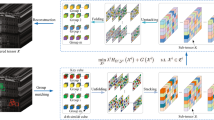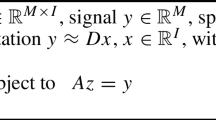Abstract
The main purpose of this article is to study a new model of low rank tensor completion. The goal is to predict missing values from a small set of observations. More particular, we present a model of hyperspectral images completion based on a tensor factorization guaranteeing the low rank property and a bi-regularization term promising the preservation of local details in the reconstruction. Such a factorization is used to decompose the tensor as the tensor-matrix mode-3 product of a low-dimensional tensor and a low-dimensional matrix. The bi-regularization term is given by the combination of the piecewise smoothing properties and the coherence constraint between the spectral bands of hyperspectral images. For the minimization process, we consider a Proximal Alternating Minimization (PAM) algorithm to solve the tensor completion model. Several numerical experiments were presented to demonstrate the performance of our proposed method compared to other tensor completion methods in terms of visual and quantitative measurements.






Similar content being viewed by others
References
Chang, Y., Yan, L., & Zhong, S. (2017). Hyperspectral image denoising via spectral and spatial low-rank approximation. In 2017 IEEE International Geoscience and Remote Sensing Symposium (IGARSS) (pp. 4193–4196). IEEE.
Yang, J.-H., Zhao, X.-L., Mei, J.-J., Wang, S., Ma, T.-H., & Huang, T.-Z. (2019). Total variation and high-order total variation adaptive model for restoring blurred images with cauchy noise. Computers & Mathematics with Applications, 77(5), 1255–1272.
Zhuang, L., & Bioucas-Dias, J. M. (2018). Fast hyperspectral image denoising and inpainting based on low-rank and sparse representations. IEEE Journal of Selected Topics in Applied Earth Observations and Remote Sensing, 11(3), 730–742.
Li, F., Ng, M. K., & Plemmons, R. J. (2012). Coupled segmentation and denoising/deblurring models for hyperspectral material identification. Numerical Linear Algebra with Applications, 19(1), 153–173.
Zhao, X.-L., Wang, F., Huang, T.-Z., Ng, M. K., & Plemmons, R. J. (2013). Deblurring and sparse unmixing for hyperspectral images. IEEE Transactions on Geoscience and Remote Sensing, 51(7), 4045–4058.
Chen, Y., Huang, T.-Z., Zhao, X.-L., & Deng, L.-J. (2018). Hyperspectral image restoration using framelet-regularized low-rank nonnegative matrix factorization. Applied Mathematical Modelling, 63, 128–147.
Zhao, Q., Zhang, L., & Cichocki, A. (2015). Bayesian cp factorization of incomplete tensors with automatic rank determination. IEEE transactions on pattern analysis and machine intelligence, 37(9), 1751–1763.
Yokota, T., Lee, N., & Cichocki, A. (2016). Robust multilinear tensor rank estimation using higher order singular value decomposition and information criteria. IEEE Transactions on Signal Processing, 65(5), 1196–1206.
Korah, T., & Rasmussen, C. (2007). Spatiotemporal inpainting for recovering texture maps of occluded building facades. IEEE Transactions on Image Processing, 16(9), 2262–2271.
Ji, T.-Y., Huang, T.-Z., Zhao, X.-L., Ma, T.-H., & Deng, L.-J. (2017). A non-convex tensor rank approximation for tensor completion. Applied Mathematical Modelling, 48, 410–422.
Varghees, V. N., Manikandan, M. S., & Gini, R. (2012). Adaptive MRI image denoising using total-variation and local noise estimation. In IEEE-International Conference On Advances In Engineering, Science And Management (ICAESM-2012) (pp. 506–511). IEEE.
Candès, E. J., & Recht, B. (2009). Exact matrix completion via convex optimization. Foundations of Computational mathematics, 9(6), 717–772.
Candes, E. J., & Plan, Y. (2010). Matrix completion with noise. Proceedings of the IEEE, 98(6), 925–936.
Liu, J., Musialski, P., Wonka, P., & Ye, J. (2012). Tensor completion for estimating missing values in visual data. IEEE transactions on pattern analysis and machine intelligence, 35(1), 208–220.
Xu, Y., Hao, R., Yin, W., & Su, Z. (2013). Parallel matrix factorization for low-rank tensor completion. Preprint retrieved from http://arxiv.org/abs/1312.1254
Zheng, Y.-B., Huang, T.-Z., Ji, T.-Y., Zhao, X.-L., Jiang, T.-X., & Ma, T.-H. (2019). Low-rank tensor completion via smooth matrix factorization. Applied Mathematical Modelling, 70, 677–695.
Mohaoui, S., Hakim, A., & Raghay, S. (2021). Tensor completion via bilevel minimization with fixed-point constraint to estimate missing elements in noisy data. Advances in Computational Mathematics, 47(1), 1–27.
He, W., Yao, Q., Li, C., Yokoya, N., & Zhao, Q. (2019). Non-local meets global: An integrated paradigm for hyperspectral denoising. In Proceedings of the IEEE/CVF Conference on Computer Vision and Pattern Recognition (pp. 6868–6877).
Zheng, Y.-B., Huang, T.-Z., Zhao, X.-L., Chen, Y., & He, W. (2020). Double-factor-regularized low-rank tensor factorization for mixed noise removal in hyperspectral image. IEEE Transactions on Geoscience and Remote Sensing, 58(12), 8450–8464.
Attouch, H., Bolte, J., Redont, P., & Soubeyran, A. (2010). Proximal alternating minimization and projection methods for nonconvex problems: An approach based on the kurdyka-łojasiewicz inequality. Mathematics of operations research, 35(2), 438–457.
Attouch, H., Bolte, J., & Svaiter, B. F. (2013). Convergence of descent methods for semi-algebraic and tame problems: proximal algorithms, forward-backward splitting, and regularized gauss-seidel methods. Mathematical Programming, 137(1), 91–129.
Moreau, J. J. (1962). Fonctions convexes duales et points proximaux dans un espace hilbertien. Comptes rendus hebdomadaires des séances de l’Académie des sciences, 255, 2897–2899.
Boyd, S., Parikh, N., & Chu, E. (2011). Distributed optimization and statistical learning via the alternating direction method of multipliers. Now Publishers Inc.
Ji, T.-Y., Huang, T.-Z., Zhao, X.-L., Ma, T.-H., & Liu, G. (2016). Tensor completion using total variation and low-rank matrix factorization. Information Sciences, 326, 243–257.
Li, X., Ye, Y., & Xu, X. (2017). Low-rank tensor completion with total variation for visual data inpainting. In Proceedings of the AAAI Conference on Artificial Intelligence (vol. 31).
Wang, Z., Bovik, A. C., Sheikh, H. R., & Simoncelli, E. P. (2004). Image quality assessment: from error visibility to structural similarity. IEEE transactions on image processing, 13(4), 600–612.
Author information
Authors and Affiliations
Corresponding author
Ethics declarations
Competing Interests
The authors declare that they have no competing interest.
Additional information
Publisher’s Note
Springer Nature remains neutral with regard to jurisdictional claims in published maps and institutional affiliations.
Rights and permissions
Springer Nature or its licensor holds exclusive rights to this article under a publishing agreement with the author(s) or other rightsholder(s); author self-archiving of the accepted manuscript version of this article is solely governed by the terms of such publishing agreement and applicable law.
About this article
Cite this article
EL Qate, K., El Rhabi, M., Hakim, A. et al. Hyperspectral Image Completion Via Tensor Factorization with a Bi-regularization Term. J Sign Process Syst 94, 1545–1555 (2022). https://doi.org/10.1007/s11265-022-01817-9
Received:
Revised:
Accepted:
Published:
Issue Date:
DOI: https://doi.org/10.1007/s11265-022-01817-9




